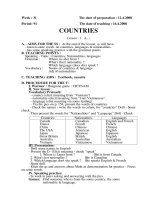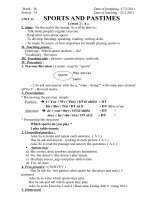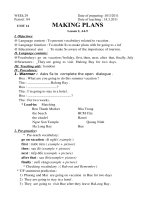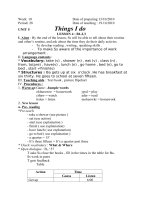Giáo Án Anh Văn 6 Chuẩn Năm 2009 (tiết 94-96)
Bạn đang xem bản rút gọn của tài liệu. Xem và tải ngay bản đầy đủ của tài liệu tại đây (612.18 KB, 44 trang )
Week : 33 The date of preraration : 6.4.2011
Period : 94 The date of teaching : 13.4.2011
UNIT : 15
COUNTRIES
Lesson :4, B4-5
I . Objectives:
By the end of the lesson Ss will be able to understand the passage, answer the
questions and introduce about some famous places which Ss know.
To develop listening, speaking and reading skills.
To educate Ss to ………………..
II. Language contents:
@Vocabulary: high , thick, structure, the Great Wall
@Structures : _How t hick is the Great Wall ? _ It is over 9 meters high .
II. Techniques / activities : picture, translation, example, gap-filling, substitution
III. Teaching aids: handout
IV. Procedures:
1. Warm up :
Asks Ss to write the comparative / superlative sentence :
a. Saigon / hot / Ha Noi b. winter / cold / season / the year
2. Pre-practice:
* Pre-teach vocabulary:
thick (a) : dày ( picture )
structure (n) : cấu trúc (translation )
kilometer (n) : 1 kilometer = 1000 meters : cây số (explanation) :
the Great Wall : Vạn Lý Trường Thành (picture)
* Checking vocabulary : ( Rub out and Remember )
* Pre-teach the structure:
How t hick is the Great Wall ? It is over 9 meters high .
How + adj + is + Subject
It + is + số đo + adj
* T/F statement prediction :
a) Petronas Twin Towers is higher than Sears Tower . __
b) The Great Wall is over 6000 meters . __
c) It is about 8 meters high . __
d) It is 9 meters long . __
3. Controlled-practice :
Asks Ss to read the text , check their prediction and correct the false
statement.
KEY : 1_ T , 2_ F , 3_ T , 4_ F
_ Asks Ss to answer the questions .
4. Free-practice :
( Answer Given ) ( Key )
Chicago Where is Sears Tower ?
442 meters How high is Sears Tower ?
Petronas Twin Towers Which is the highest building in the world ?
The Great Wall Which is the longest structure in the world?
China Where is The Great Wall ?
6000 kilometers How long is The Great Wall ?
Mexico City Which is the biggest city in the world ?
Tokyo Which is smaller , Mexico City or Tokyo ?
Asks Ss to fill in the blank in the passage :
Sears Tower is in Chicago . It is ……………………….than Petronas Twin Towers in
Kuala Lumpur , the highest ……………………………….in the world .
The Great Wall of China is over 6000 meters ………………. . It is the ……………………..
structure in the world .
5. Correct the test
ÑAÙP AÙN
I . Pronunciation: (4 x 0.25 = 1 m )
Caâu A B C D
1 x
2 x
3 x
4 x
II. :Lexico-Grammar:(14 x 0,25 = 3,5ms)
Caâu A B C D
1 x
2 x
3 x
4 x
5 x
6 x
7 x
8 x
9 x
10 x
11 x
12 x
13 x
14 x
III. Reading: (8 x 0,25 = 2ms)
Caâu
A B C D
1 x
2 x
3 x
4 x
1. There are four seasons in a year .
2. They are spring, summer, fall and winter.
3. People often go swimming in the summer.
4. No, it isn’t.
IV – Write (2,5ms):
1. Let’s go to the cinema
2. Why don’t we go to the beach?
3. What about playing volleyball?
4. What is Hue city like?
5. I’m going to stay with my aunt and uncle.
V. Listening : (4 x 0,25 = 1 m)
1.on 2. in 3.with 4. and
6. Homework :
_ Asks Ss to learn the new words by heart .
_ Asks Ss to translate the text into Vietnamese.
_ Prepare C1,2
• Self –evaluation:
………………………………………………………………………………………………………………………………………………………………………………
…………………………………………………………………………………………………………………………….
Week : 33 The date of preraration : 6.4.2011
Period : 95 The date of teaching : 15.4.2011
UNIT : 15 COUNTRIES
Lesson 5 : C 1-2
I_ Objectives :
@ Language content : To present vocabulary related to natural features
@ Language function : To enable Ss to describe natural features
@ Educational aim : To make Ss love the nature and the country.
To develop 4 skills.
II. Language contents:
@Vocabulary: lots of,a lot of, much, natural features, rain , forest, desert
@Structures : lots of / a lot of/ much
III. Teaching aids: handout
IV. Procedures:
1. Warm up:
_ Asks Ss to answer these questions:
1) Which is higher , Sears Tower or Petronas Twin Towers ?
2) How long is The Great Wall ?
3) Is The Great Wall the longest structure in the world ?
* Lead in :
Asks Ss to tell what each picture is .
Asks Ss to guess the aim of the lesson .
Tells the aim of the lesson : describing natural features
2. Pre-practice:
* Pre-teach vocabulary:
nature (n ):thieõn nhieõn _ natural (a): thieõn nhieõn _feature (n ): ủaởc trửng
_ great (a) : big ( synonym ) _ such as : nhử laứ ( example )
_ rain (n) : cụn mửa _ rain (v) ; mửa
_ forest (n) : rửứng _ desert (n) : sa maùc ( picture )
- lots of / a lot of/ much
* Checking vocabulary : ( Rub out and Remember )
* tick prediction : _ Asks Ss to complete the chart.
3. Controlled-practice :
Asks Ss to read the text and check their prediction.
Asks Ss to fill in the blank in the passage with the suitable word.
Viet Nam is a beautiful country. Viet Nam has lots of ( picture A ) ………….
It has great ( picture B )……..such as the Red River and the Mekong River. It has a lot of
( picture C )……….. .In Viet Nam , it usually rains ;so,the country is very green. There are
big ( picture E )………………….and there are many beautiful ( picture F )……………….Viet Nam
doesn’t any ( picture G)…………………. .
4. Free-practice :
_ Asks Ss to answer the questions :
1) Does Viet Nam have lots of mountains ?
2) Which great rivers does Viet Nam have ?
3) Which beaches are there in Viet Nam ?
4) Which beach do you like best ?
5) What season does it usually rain ?
6) Are forests in Viet Nam big ?
7) Which lakes does Viet Nam have ?
_Asks Ss to listen the passage and number the words they hear.
V. Homework :
_ Asks Ss to learn the new words by heart .
_ Asks Ss to translate the text into Vietnamese.
- Exercises 1, 2 - P.130 - Workbook.
- Prepare C3
* Self –evaluation :
Viet Nam
has
Viet Nam doesn’t
have
mountains
great rivers
lakes
deserts
beautiful
beaches
rain
forests
mountains 1
rains
beaches
lakes
deserts
rivers
forests
…………………………………………………………………………………………………………………………….
Week : 33 The date of preraration : 6.4.2011
Period : 96 The date of teaching :18.4.2011
UNIT : 15 COUNTRIES
Lesson 6 : C 3
I. Objectives :
@ Language content : To present vocabulary related to natural features.
@ Language function : To enable Ss to describe natural features
@ Educational aim : To make Ss love the nature and the country.
II. Language contents
@Vocabulary: start, flow, gulf , Mediterranean sea, ocean , Mount Everest,
north, south, east, west
@Structures : We have lots of mountains
III _Teaching aids : handout
IV- Procedures:
1. Warm up :
_ Asks Ss to look at the map of Viet Nam and identify the rivers and mountains .
_ Asks Ss to guess the aim of the lesson .
_ Tells the aim of the lesson : describing natural features in the world
( rivers and mountains )
2. Pre-practice:
* Pre-teach vocabulary:
_ start (v): bắt nguồn _ flow to(v): chảy về, đổ về ( example + picture )
_ gulf (n): bay ( synonym) :vònh _sea (n) : biển ( picture )
_ Mediterranean sea : biển Đòa Trung Hải
_ ocean (n) : đại dương ( scale) lake _ river _ sea _ ocean
_ mount (n) : ngọn núi Mount Everest
north
west east
south
* Checking vocabulary : ( Rub out and Remember )
* T/F statement prediction :
_Asks Ss to listen to the passage and decide if the statements are T/F.
1) The Mekong River is shorter than The Red River. __
2) The Mekong and The Red River start in China. __
3) The Mekong flows to the Bien Dong . __
4) The longest river in the world is the Nile River . __
5) Mount Everest is higher than Phanxipang. __
3. Controlled-practice :
_ Asks Ss to read the text , check their prediction and correct the false
statement.
KEY: 1_ F , 2_ F , 3_ T , 4_T , 5_ T
_ Asks Ss to answer the questions.
4. Free-practice :
_ Asks Ss to give natural features ( rivers and mountains) in Binh Dinh .
_ Asks Ss to fill in the blank in the passage with the suitable word.
V. Homework :
_ Asks Ss to learn the new words by heart .
- Exercises 3 - P.131 - Workbook.
- Prepare unit 16 A1,2,3
* Self –evaluation :
…………………………………………………………………………………………………
…………………………………………………………………………………………………
…………………………………………………………………………………………………
……………
Week 34 Date of making: 15/04/2011
Period 97 Date of teaching: 19/04/2011
UNIT 16 : MAN AND THE ENVIRONMENT
Section A – ANIMALS AND PLANTS ( A1,3 )
I. Objectives
By the end of the lesson, students will be able to use the questions “ How
much”
“ How many” & indefinite quantifiers: some, a lot, a little, a few to talk about
food. And read a text about farming .
II. Language contents
Grammar: How much is there ? There is a lot of / a little rice
How many eggs are there ? There are a lot of / some / a few eggs.
Vocabulary:
III. Techniques: pair work, chatting, jumble words
IV. Teaching aids: pictures, cassette, flash card.
V. Procedures
Teacher and students’ activities Contents
A. Warm up :
- Use the methods jumbled words,
Ss : do as directed
B.Presentation
- Use the picture to introduce the
context
-Give some questions
-Ss: look at the pictures and
answer.
-Write the questions and the
answers on the board.
-Explain and give structures
-Ss: listen and copy.
* Jumble words
toespota = potatoes gegs = eggs
werflos = flowers icer = rice
motatoes = tomatoes nonios
1. Listen and repeat
How much rice is there?
ex:There is some rice
a lot of / lots of rice
a little rice
ex:How many eggs are there?
-Let Ss look at the pictures of A 3
on page 167 and do the matching
while listening.
-Ss: work individually.
-T: give correct answers.
C Listening:
1.pre-litening
T ask Ss to say the pictures in
English
3.While-reading
- T plays the tape twice
- Ss listen and write the letters of
the picture under the right
heading
-T gives correct answers.
D.Production:
- Remind the model sentences
Ss : listen
- Show the picture and make
questions
-Ss answer
There are some eggs
a lot of / lots of eggs
a few eggs
* Notes
+ some / a lot of / lots of / a little + N
(khoâng m c)đế đươ
+ some / a lot of / lots of / a few + N
( m c s nhi u)đế đượ ố ề
2.Practice: Matching (A 3)
*
The tape transcrip
1.There are a lot of vegetables
2.There are some flowers.
3.there are some tomatoes.
4.There are a lot of potatoes
5.There are a few onions
6.there is a little rice.
1.d 2.f 3.b 4.a 5.c 6.e
* Picture drill (A 1- A 3)
Ex:S1: How much rice is there?
S2: There is a lot of rice
Ex: S1:How many onions are there?
S2: There are a few onions.
* HOMEWORK : - Learn the structures and vocabulary by heart.
-Prepare next part ‘ A 2’
* Self –evaluation :
…………………………………………………………………………………………………
…………………………………………………………………………………………………
…………………………………………………………………………………………………
……………
_______________
Week 34 Date of making: 15/04/2011
Period 98 Date of teaching: 22/04/2011
UNIT 16 : MAN AND THE ENVIRONMENT
Section A – ANIMALS AND PLANTS ( A2 )
I. Objectives
By the end of the lesson, students will be able to use the questions “ How
much”
“ How many” & indefinite quantifiers: some, a lot, a little, a few to talk about
food. And read a text about farming .
II. Language contents
Grammar:
Vocabulary: animals, buffalo, cow, plow, pull a cart, grow, (to) produce
III. Techniques: pair work, chatting, jumble words
IV. Teaching aids: pictures, cassette, flash card.
V. Procedures
Teacher and students’ activities Contents
1. Warm up :
Ask Ss some questions
Ss answer
2. Pre-raeding
- Explain some new words by
using pictures, translation
Ss : listen and copy down - repeat
- Play the tape again and get Ss to
repeat ( chorus – individual)
Ss : do as directed
-Ss: predict 6 things Mr Hai has on
his farm and five things he
produces
-Give feedback
3.While-reading
- Have Ss read the text and check
their prediction
-Give answer key
1. Who is this?
2. What does he do?
3. Where does he live?
4. What does he grow ?
5. Which animals does he have?
A2:Listen and read .Then answer the
questions
a.Voaobulary
-a buffalo (pict)
-to grow (act/pict)
-to produce (trans)
-to plow (trans / pict)
-pull a cart (trans)
-enviroment (trans)
-a dog (pict)
-a cat (pict)
-a cow (pict)
-an animal (example)
b.open prediction (with answer key)
a.Checking prediction
*Mr Hai has:
1.paddy field 2.a small vegetable
field
3.fruit trees 4.buffalo
-Ask Ss to practice in pairs to ask
and answer the questions
Ss : do as directed
-T gives correct answers.
4.Post-reading
- Remind the model sentences
Ss : listen
- Show the picture and make
questions
-Ss answer
5.cows 6.chickens
* Mr Hai produces:
1.rice 2.vegetables
3.fruit 4.milk 5.
eggs
b.Comprehentsion Questions :
a.He produces of rice
b.Yes, he does
c.He produces a little fruit
d.They produce a little milk
e.They produce a lot of eggs.
* HOMEWORK : - Learn the structures and vocabulary by heart.
-Prepare next part ‘ A 4,5’
* Self –evaluation :
……………………………………………………………………………………………………………………………………………
Week 34 Date of making: 15/04/2011
Period 99 Date of teaching: 23/04/2011
UNIT 16 : MAN AND THE ENVIRONMENT
Section A – ANIMALS AND PLANTS ( A4, 5 )
I/ Objectives:
By the end of the lesson, students will be able to can read a text bout the
environment to understadn ideas in term of cause and effect “why...?”
“because....”
II/ Language contents:
Grammar : How much is there ? There is a lot of / a little rice
How many eggs are there ? There are a lot of / some / a few
eggs.
Vocabulary : cut down, burn, destroy...
III. Techniques : pair work ; chatting, matching
IV/ Teaching aids : pictures ; cassette, flash card
V/ Procedures
Teacher’s and sts’ activities Contents
A.Warm up:
- Call two ss to go to the board
and do the matching
Ss: do as teacher’s directed
-Give correct answer .
B.Pre-reading
- Stick the picture on the
board, then set the scence
Ss: Listen , look at the picture
and guess the content of the
text
- Explain some new words
and read.
-Ss: listen and repeat
- Stick the pictures on the
board
- Read the text,
-Ss: listen and order them
without looking their books..
* Matching
1.the population
2.the world
3. grow
4.food
5.forest
6.farmer
7.fields
8.animals
a.r mgừ
b.tr ng ồ
c.caùnh ngđồ
d.daân số
e. ng v tđộ ậ
f.noâng daân
g.th c nứ ă
h.th gi iế ớ
* Set the scence
1.pre-teach.
-land (n) (pict)
-to cut down (pict)
-to burn (trans)
-to destroy (trans)
-dangerous (adj) (trans)
a danger (trans)
* Check Vo: Slap the board
2.Ordering pictures
C.While-reading
-Ss read the text and check
their prediction.
-T: give correct answers.
-T: explain Grammar.
SS: listen and coppy.
-Ss: practice asking and
answering the questions on
page 168 in pairs.
D. Post –reading
- Have Ss work in groups
Ss: Re-tell the text in their
own words using the
“ordering” pictures as cues
1.Checking prediction
1.e 2.c 3.b 4.d 5.f 6.a 7.g
*Grammar: Question with “why’
-Từ hỏi ‘Why’đdược duøng ñeå hỏi lí do hoặc
nguyeân nhaân. Ñeå trả lời cho caâu hỏi nay ta duøng
‘because’
Why + aux.verb + S + V........?
Because + S + V.............
2.Comprehension questions
a.because we need more food.
b.Because we need more farm and land
c.Because people are destroying their home
and environment.
* Picture story ( Recall)
* HOMEWORK : -Leam vocabulary and structures by heart.
-Prepare nexr part ‘B1,2’
* Self –evaluation :
…………………………………………………………………………………………………
…………………………………………………………………………………………………
…………………………………………………………………………………………………
……………
Week 35 Date of making: 20/04/2011
Period 100 Date of teaching: 25/04/2011
UNIT 16 : MAN AND THE ENVIRONMENT
Lesson 3 : Section B – POLLUTION (B1,2)
I/ Objectives:
By the end of the lesson, students will be able to can read a text about pollution
for vocabulary and understand ideas and know more about how to use some
structures
II/ Language contents:
Grammar : - Present progressive tense.
- Imperative
Vocabulary : the environment, the ocean, the air, trash, polute, waste...
III. Techniques : pair work ; chatting, matching
IV/ Teaching aids : pictures ; cassette, flash card
V/ Procedures
Teacher’s and sts’ activities Contents
A. Warm up :
- Call two Ss to go to the
board and play slap the
board.
Ss : do as teacher’s directed
* Activity 1:
B. Pre-reading
- Use the picture to introduce
the context
Ss : listen
T: play the tape and ask sts
listen one time
Ss : listen
- Explain some new words by
using pictures, translation
Ss : listen and copy down -
repeat
- Play the tape again and get
Ss to repeat ( chorus –
individual)
Ss : do as directed
* Slap the board.
caây phaù huỷ đốn hạ caây sản xuất
con vật đất đai
* Set the scene
1 Vocabulary :
-the environment (trans)
-the ocean = the sea
-the air (trans)
-trash (n) (pict)
-to pollute (trans)
-to waste (trans)
-coal (n) trans)
-gas (n) (trans)
-oil (n) (trans)
-power (n) (exam)
* Check Vo: R & R
* Model sentences
We are destroying the forests
S + is / am / are + V
- ing
+ . . .
- Remind the progressive
tense
Ss: Listen and copy
-Have Ss guess and answer
the questions.
-Give feedback
C.While -reading
- Get Ss to read the text and
check their prediction.
-Give answer key.
- Get Ss to read the text again
and answer the questions on
page 170 in pairs.
Ss : do as directed
-Give correct answers,
D.Post-reading:
- Read the text B1 on page
169
-Ss: listen and order the
words from vocabulary.
* Activity 2:
B.Presentation :
-Ss work out the meaning of the
new verbs from the pictues and fill
the Vietnamese meanings
-T: correct.
2.Pre-questions
a.What are we destroying?
b.What are we wasting?
c.What are we polluting?
1.Checking prediction
a.We are destroying forests, wild animals
and plants.
b.We are wasting water, power (coal, oil, gas)
c.We are polluting the air, the land, the
rivers, and the oceans.
2.Comprehension questions
a.Beause we are destroing wildanimals and
plants.
b.Gases are polluting the air.
c.The pollution comes from gases snd trash.
d.Trash is polluting the land, the rivers and
the oceans.
* Ordering vocabulary (with answer key)
1.the environment 2.waste
3.coal 4.oil
5.gas 6.power
7.pollute 8.the air
9.trash 10.the ocean
1.Guess from context
-to throw:
-to pick:
-to damage:
-to keep off :
-to save:
-to collect:
neùm
nhặt
hư hại
traùnh xa
tiết kiệm
thu gom
2.Matching.
a.Don’t throw trash on the street. c
b.Don’t pick flowers f
c.Don’t damage trees. a
Ss: match the rulers with
these sings on page 170 in
groups.
-Give feedback
-T: correct and give answer
key.
-T: give the model sentences
-Ss : listen and copy.
C.Practice
T: call on some Ss to go to the
board and do the matching
Ss : do as directed
-Give correct answers
Ss use the table of matching
and the pictures of B 2 to
practice speaking.
-Ss can use the model
sentences.
D.Production::
- Guild Ss to play the game.
-T: give structures.
d.Don’t thow trash in the country. h
e.Leep off the grass e
f.Save water. b
g.collect paper g
h.Collect bottles and cans d
3.Model sentences
Model verbs: Should (nên)
Ex1: We should collect paper.
Ex2: We shouldn’t throw trash on the
streets.
1.Matching
Should
Shouldn’t
damage
collect
throw
save
pick
trash
trees
paper
flowers
bottles and
cans
2.Picture drill (B 2)
S1: We shouldn’t damage trees.
S2: That’s right.
Noughts and Crosses
damage save waste
destroy pollute collect
throw cut down pick
Ex: We shouldn’t pollute the air.
*Structures: Should (neân )
S + should + V...
S + should not + V......
(should not = shouldn’t : khoâng neân )
-Ss: listen and copy.
* HOMEWORK : -Prepare next part B4,5,6
-Learn by heart new words
* Self –evaluation :
Week 35 Date of making: 20/04/2011
Period 101 Date of teaching: 26/04/2011
UNIT 16 : MAN AND THE ENVIRONMENT
Lesson 5 B : Pollution (B 4,5,6)
I. Objectives : By the end of the lesson, students can do firther practicein shold
and shouldn’tfor giving advice about the invironment.
II. Language contents :
Grammar : We shouldn’t waste water.
We should save gas.
Vocabulary : trash can, leave, bag....
III. Techniques : pair work, chatting, group work.
IV. Teaching aids : pictures ; cassette, sub-board
V.Procedures :
Teacher and sts’ activities Contents
A. Warm up :
-Call on one student to go to
the board and put the letters
in correct order.
B. Practice
- Explain some new words
Ss : listen and copy down –
repeat
- Read the text , Ss listen and
repeat
-Ss read cholly
-Help Ss remember the
* Jumbled words
-llcoct = collect -wplo = plow
-plloute = pollute -eavs = save
-ckpi = pick -htrow = throw
1.pre-teach Vocabulary :
-a trash can = a waste basket
-to leave ( act)
-to put (ast)
-a bag (drawing/ pict)
2.Rub Out And Remember Dialouge.









